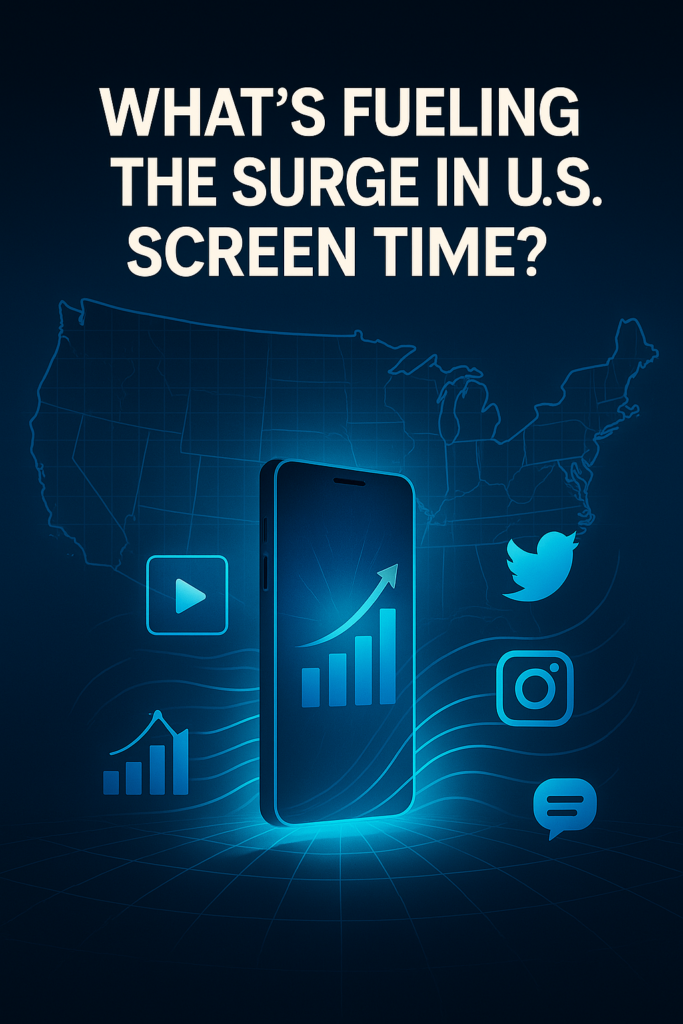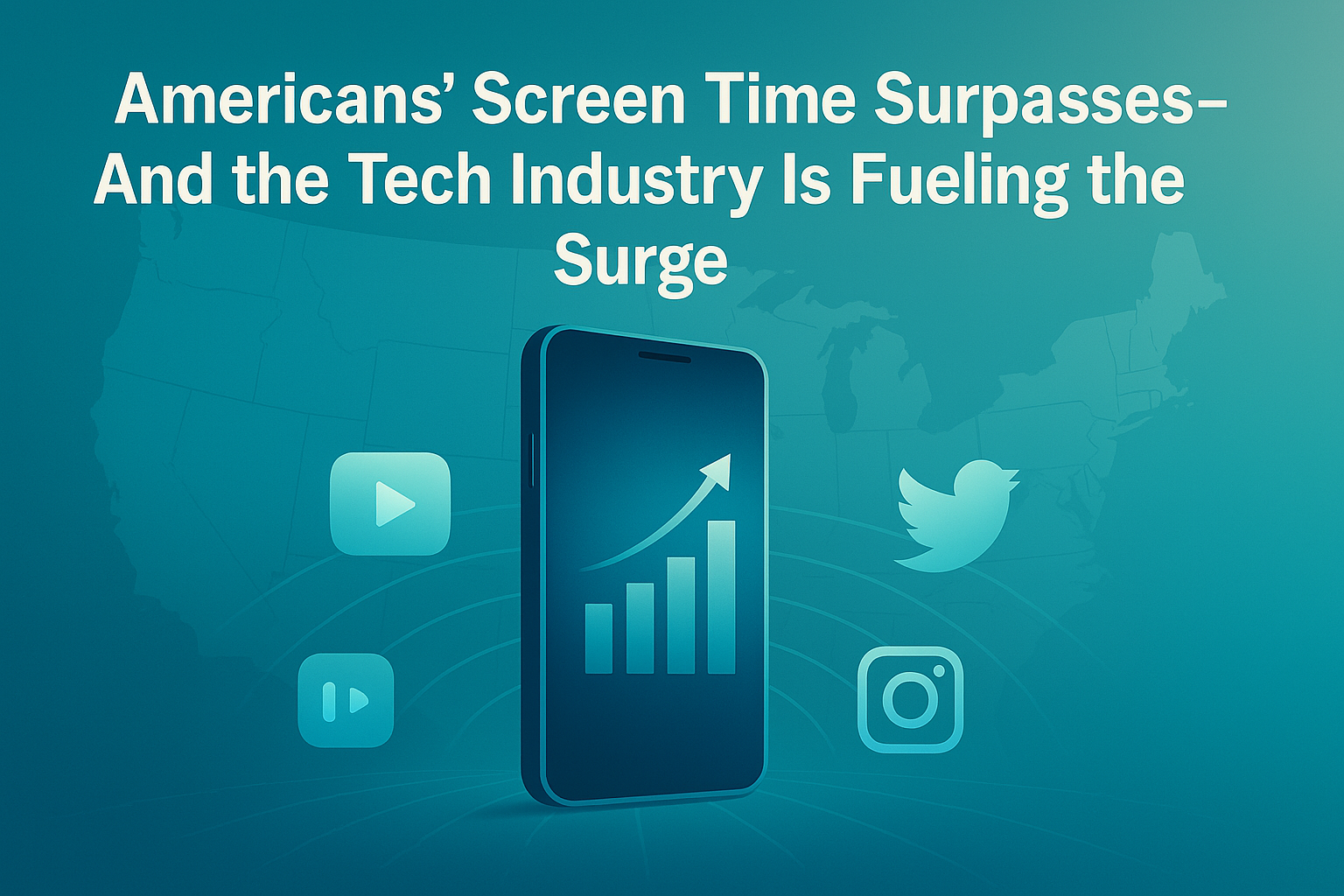Americans Screen Time Is Surging—Techestateempire Breaks Down What It Means for Health, Innovation, and Society
Americans screen time is at a record high, and it’s starting to raise alarms across the health and tech sectors. According to new research, the average U.S. adult now logs six hours and 40 minutes of screen time per day, surpassing the global average of six hours and 37 minutes source.
While a three-minute lead may not seem significant, the cultural and behavioral implications are enormous. In 2025, screen time is no longer just a stat—it’s a signal of how we live, work, consume, and even sleep.
At Techestateempire, we examine why Americans lead the world in screen exposure, how this affects health and society, and what role the tech industry must play in reversing the trend.
Why Is Americans Screen Time Higher Than the Global Average?

1. Remote Work and the “Always Online” Economy
The rise of remote work means Americans are tethered to screens even longer. From Slack to Zoom to email, today’s worker may spend 10+ hours daily on screens across work and personal tasks.
This shift has its roots in the post-pandemic economy, as we explored in our breakdown of digital infrastructure gaps following government layoffs.
2. Social Media and Algorithmic Hooking
Americans are spending over 2.5 hours per day on social media platforms like TikTok, Instagram, Facebook, and X (formerly Twitter), according to DataReportal. These platforms are engineered to maximize time spent, often using psychological triggers like infinite scroll, likes, and targeted content to extend sessions far beyond initial intent.
We analyzed this phenomenon further in AI-Driven Attention Economies, where we examined how tech companies design content loops to capture users longer.
3. Entertainment on Demand
With endless content available on Netflix, Hulu, YouTube, Disney+, and more, Americans are streaming for 3+ hours daily, often while multitasking on other devices.
Gaming also contributes to screen time spikes, especially with cross-device play between consoles, smartphones, and PCs. A 2023 study by Nielsen noted that digital video makes up more than 50% of U.S. screen time.
What Are the Health Risks of High Americans Screen Time?
Physical Health Risks
- Digital eye strain, headaches, and blurred vision
- Poor posture, known as “tech neck”
- Sedentary lifestyle increasing risk of obesity and cardiovascular disease
Mental Health Concerns
- Increased anxiety, depression, and FOMO (fear of missing out)
- Sleep disruption from blue light exposure before bedtime
- Decision fatigue and reduced productivity from constant digital multitasking
As we noted in our deep dive on GPU fatigue in AI developers, even high performers are reaching cognitive burnout at alarming rates.
What Should Tech Companies Be Doing?
Yes, screen time is a user choice—but tech companies build the architecture of that choice.
Current solutions like Apple’s Screen Time or Android’s Digital Wellbeing offer usage analytics, but they often lack meaningful friction. Many users override limits or ignore notifications altogether.
Here’s what needs to happen:
- Default screen limits for social and streaming apps
- In-app “pause” modes for focus, sleep, and meals
- Gamified downtime tools to incentivize healthy habits
- Corporate accountability from platforms that profit off addiction
As discussed in Why Tech Leaders Are Quiet on Major Policy Shifts, silence from executives on these issues speaks volumes.
What Can Users Do to Reduce Screen Time?
You don’t need to unplug completely to create a healthier relationship with your devices. Try:
- Using the 20-20-20 rule: every 20 minutes, look 20 feet away for 20 seconds
- Installing apps like Forest or Freedom to block distractions
- Charging your phone outside your bedroom
- Replacing 30 minutes of daily scroll time with reading, walking, or journaling
- Creating tech-free zones like the dining table or family room
Looking Ahead: Is 8 Hours of Screen Time Next?
If the trend continues, U.S. screen time could exceed 8 hours daily by 2030. And with multi-screen behavior (watching TV while browsing social media), the actual impact is already higher than the data suggests.
The question isn’t whether screen time will grow—it’s how we choose to manage it.
Final Thoughts
The steady rise in American screen time is more than just a tech trend—it’s a societal shift with far-reaching consequences. At over 6.5 hours a day, screen exposure is no longer something we “do”; it’s the environment we live in. Whether we’re working, relaxing, socializing, or even trying to sleep, screens are often the central medium through which our lives unfold.
At Tech Estate Empire, we see this as a defining moment not only for personal health but for the future of technology itself.
A Signal of a Deeper Problem
This isn’t just about spending too much time on TikTok or watching one too many Netflix episodes. It’s about a tech ecosystem built on overconsumption—one that thrives on maximizing attention and monetizing time. The infrastructure of modern technology—from algorithms to notification systems—is designed not to serve us, but to hold us hostage.
The fact that Americans lead the world in screen time isn’t a badge of digital advancement. It’s a warning signal that our tools may be using us more than we’re using them.
A Missed Opportunity for Tech Leaders
What’s most alarming is the lack of meaningful response from the very companies that helped create this culture of excess. While Big Tech occasionally nods toward digital wellness—through screen time reports, “wind-down” features, or wellness reminders—these gestures are rarely central to their platforms or business models.
As we’ve discussed in articles like Why Tech CEOs Are Staying Silent on Trump’s Tariffs, silence and inaction from industry leaders are no longer acceptable. The same principle applies here: tech companies must take real responsibility for how their platforms affect mental health, productivity, and society.
The Road to Rebalance
The next wave of innovation shouldn’t just focus on more immersive content or smarter devices. It must be about designing for balance, not just engagement.
That means:
- Creating platforms that reward focus, not distraction
- Prioritizing long-term user health over short-term retention metrics
- Building in transparency and real user control over how time is spent
It’s not just good ethics—it’s good business. As more consumers become aware of the impact of screen time, they’ll demand products that support healthier digital habits. Companies that lead this transition will win not only in market share but in public trust.
For Consumers: Awareness is Power
Ultimately, change starts with awareness. Understanding how much time we spend on screens, and more importantly why, is the first step toward change. It’s not about going analog or rejecting technology—it’s about using tech intentionally.
At Tech Estate Empire, we believe technology should empower, not exhaust. Screen time should enhance life—not replace it.
So the next time you find yourself reflexively scrolling, binging, or toggling between tabs, pause and ask:
Is this helping me? Or just keeping me busy?
The future of tech is not just about what’s on our screens—it’s about how we engage with them. And that future begins with awareness, accountability, and a commitment to designing for human well-being.

